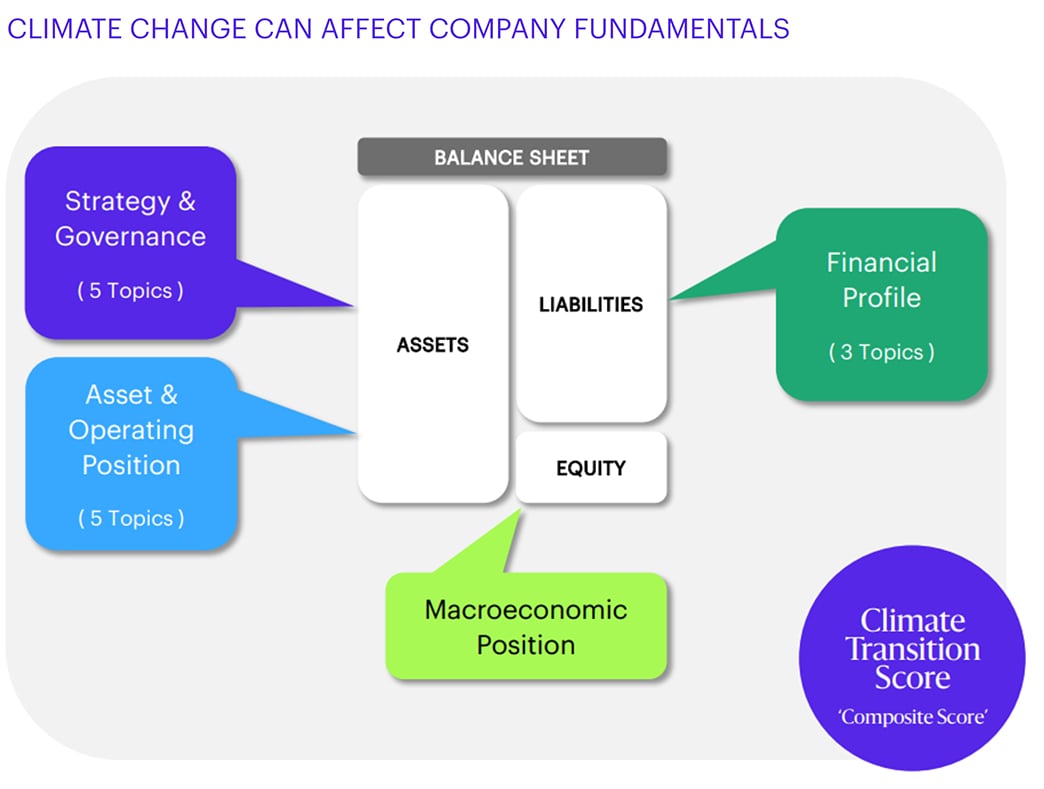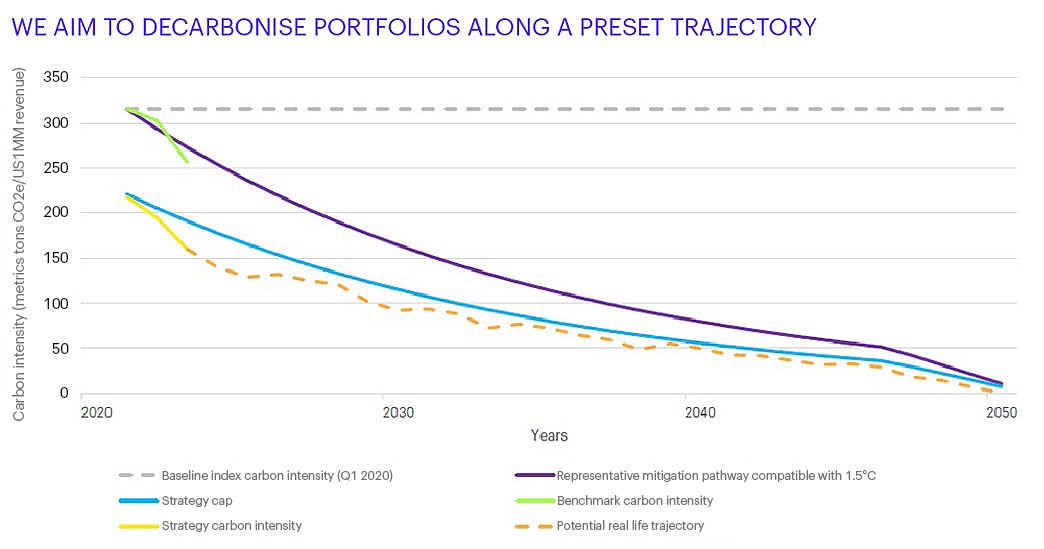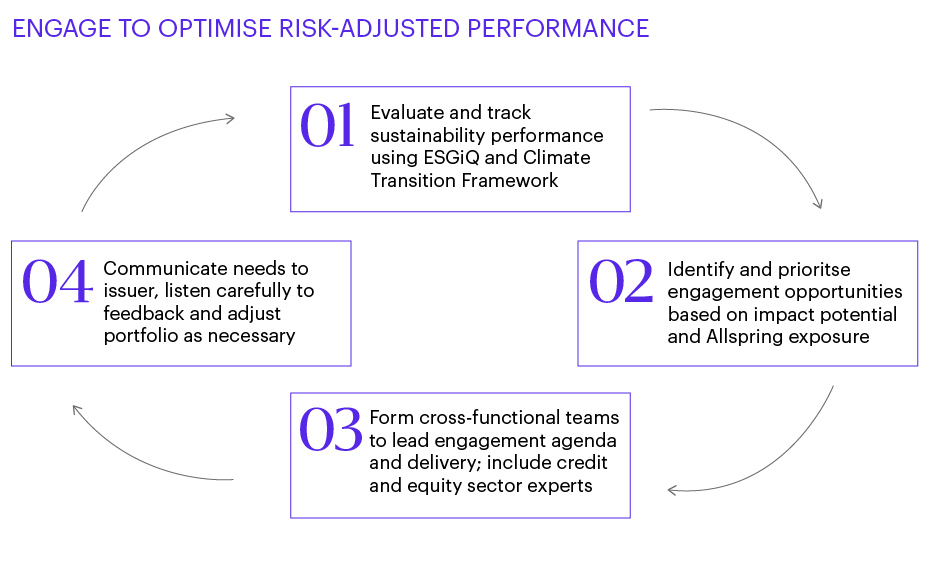Investing
Climate Transition Opportunity In Fixed Income
Seeking dual climate and financial outcomes through a proprietary framework that hit its three-year milestone in January 2024.
As the world transitions towards net-zero emissions, new opportunities and risks are opening up across markets. We believe investors need to consider repositioning their portfolios to best capture these new opportunities and manage unintended risks.
Grounded in a proven and successful investment process, Allspring has responded with a suite of climate transition credit strategies.
Allspring’s Climate Transition Framework**, married with our deep fixed income expertise, enables investors to gain exposure to the climate transition leaders of today and tomorrow, whilst also being centrally focused on meeting their financial goals.

Why fixed income for climate transition?
For clients seeking to help decarbonise the world, we believe fixed income plays a critical role and continues to represent an attractive opportunity. Why should clients focus on fixed income when investing for climate transition? We point to three reasons:
1. Financial return
Allocating capital to companies that are actively positioning themselves for a net-zero world can help avoid stranded assets and potentially increase the probability that investors will receive expected coupon and redemption payments.
2. Carbon intensity
The average weighted carbon intensity of fixed income can be higher than main equity indices.* As such, fixed income assets can be a key tool in the decarbonisation arsenal.
3. Engagement
Bondholders can make a difference through active engagement. This gives investors in credit a real opportunity to drive change. Access to capital and cost of capital are powerful levers for bondholders when engaging.
*S&P Trucost, as at 31-Dec -22

How we invest in climate transition credit
Allspring’s Climate Transition Credit approach is designed to rigorously assess investment opportunities and their associated risks and deliver optimum investor outcomes through a combined climate and financial lens.

Picking climate transition credit leaders
Using our Climate Transition Framework**, our fundamental analysts draw and build upon their deep knowledge to evaluate and score the implications of climate change on company fundamentals.
Using proprietary data and systems, our analysts fully integrate four primary categories of climate risk and opportunity—based on dozens of climate risk metrics—into their holistic, forward-looking view of the company. Companies that stand to make the most meaningful contributions to decarbonisation whilst benefitting fundamentally are prioritised in security selection. Companies that screen poorly become ineligible for portfolios.

** Our fundamental analysts evaluate the implications of climate change on company fundamentals on 14 topics across four pillars, rating each with a climate transition score between 1 and 4, importantly with a trend indicator.
Targeting an ambitious decarbonisation profile
Our strategies align with a transparent, consensus-based trajectory that is part of European Union climate benchmark policies. Key features include targeting an overall carbon intensity for the portfolio that is at least 30% lower than the benchmark and aims to decarbonise by 2050.

For illustrative purpose only. Source: Allspring and Trucost, as at 31 March 2023.
Targeted exclusion to optimize performance
We prioritise corporate engagement by impact potential, including the systemic importance of climate change itself, strategy-level exposure and our overall exposure. We do not automatically exclude industries with high historical carbon emissions; instead, we focus on companies' forward transition performance. Our inclusive approach, partnering with our fundamental equity and credit teams, is a key differentiator of how we engage.

Leveraging Allspring's ESGIQ risk-assessment framework to identify leaders and laggards
ESGIQ is a proprietary rating system we created to assess ESG risk. Our methodology enhances data from third-party providers with our analysts’ in-depth sector knowledge and expertise. The rating frame leverages high-quality ESG data and analyses from leading external data providers, enabling broader coverage than what is available from a single provider. Assessment by our fundamental investment analysts complements the vended data to ensure timeliness as well as capturing trends. We use a simple 1-through-5 scale, with 5 being the best, to articulate our assessment.

Your team of experts
Leveraging our global Fixed Income Platform resources with sustainable investing expertise, our sustainable investing professionals welcome the opportunity to partner with you to explore your objectives and help you pursue your goals.

Manager Update – Q1 2024
Climate Transition – Global Investment Grade Credit Fund
Watch Henrietta Pacquement, senior portfolio manager, head of Global Fixed Income and head of the Sustainability team, discuss fund performance drivers, portfolio positioning and opportunities in global investment grade credit markets, and reflect on the results of COP28.
Transcript
How did the fund perform in Q1? What worked well and what didn’t?
Henrietta Pacquement: The first quarter of 2024 witnessed tighter spreads and higher interest rates, leaving global investment grade credit markets close to flat year-to-date. In that context, the Climate Transition Global Investment Grade Credit Fund I Share Class outperformed its benchmark by 62 basis points, driven by security selection. So, what worked? Higher all-in yields are attracting investors to the asset class, facilitating refinancing activity that has in turn been seen as a vote of confidence from investors, allowing spreads to tighten. We had a modest spread advantage against the benchmark, which served us well this quarter. We saw positive security selection effects from banking, consumer cyclicals, and real estate. Our dry powder in Treasuries detracted from performance, but we don't see that as an issue as it brings flexibility to the portfolio.
What were the interesting developments in the portfolio over the quarter?
Henrietta Pacquement: New issuance has been prolific as U.S. issuers in particular have frontloaded supply ahead of the election cycle later this year, feeding investor appetite. Demand for deals has been elevated with books up to seven times done. We use the opportunity to consume some of our Treasury positions and rotate select real estate positions that had rallied strongly into consumer non-cyclicals and technology. We also trimmed a modest amount of euro-denominated credits and recycled them into dollar-denominated names as relative spreads have compressed between currencies.
Credit spreads have been relatively tight over the period. Where do you see the opportunities in global investment grade credit markets and how are you positioned to capture them?
Henrietta Pacquement: Now, the welcome readjustment post December's market exuberance in the interest rate markets is allowing investors another bite of the cherry. Yield curves across most jurisdictions are now back to more sensible levels and we expect them to continue to be range bound going forward as we get more inflation and growth data points. Looking at spread markets, they are pricing the benign economic environment that we're in and have tightened even as rates have risen year-to-date. A welcome change to the behaviour we saw over the last couple of years. So, where does that leave us? While spreads are tight, all-in yields are attractive and the normalisation of the yield curve will likely generate strong total returns in the intermediate part of the curve.
The portfolio is currently overweight Europe versus the U.S. What drove this decision: climate or financial considerations?
Henrietta Pacquement: So, we balance climate and financial considerations when constructing portfolios. Top-down allocations, such as currency of denomination, are driven by relative value assessments that include both valuation and technical considerations. Having been tilted to Europe in 2023, we're now more neutral given the opportunity set.
Finally, a word on COP 28. With some time now passed, what are your main reflections on what was achieved in Dubai?
Henrietta Pacquement: This is actually a controversial question. Now that time has passed, I still think the result is momentous. For the first time in 30 years, most of the globe has agreed to move away from fossil fuels. Now, obviously, we have a lot to do to make that happen, but it's a big step forward. The other takeaway for me is the notion of transition traps. I think this is an underestimated issue that needs to be taken into consideration when designing portfolio guidelines.
Climate Transition – Global High Yield Fund
Watch Sarah Harrison, senior portfolio manager for the Plus Fixed Income team, provide insights on portfolio positioning, the opportunities in global high yield markets, and how Allspring’s proprietary frameworks help to manage ESG risks while balancing both financial and climate considerations.
Transcript
The fund performed well relative to the index over Q1. What were the main contributors and what detracted?
Sarah Harrison: After the relentless rally that we saw in the fourth quarter of 2023 in which global high yield returned close to 7%, the first quarter of 2024 was relatively benign in comparison with index returns of just over a percent and a half. We benefited from our income orientation and bias to carry over convexity. Positioning in the TMT (Technology, Media, and Telecommunications) space was a significant contributor to our outperformance, including, firstly, the decision to be overweight cable versus underweight wirelines, and secondly, security selection within these two sectors. Underweight positions in potential default candidates in Europe also significantly contributed to performance. The main detractor for us from a sector perspective was our long-held underweight to real estate. Real estate will be one of the biggest beneficiaries of a lower rate environment but remains a sector where idiosyncratic issues abound.
Several issuers experienced price volatility due to governance reasons last quarter. How does the investment approach help to identify and avoid exposure to these names?
Sarah Harrison: In addition to our climate transition framework, which we have applied across our climate transition credit suite for more than three years, we at Allspring have developed a proprietary framework to assess ESG (environmental, social, and governance) risk called ESGiQ. It is used across all Article 8 funds and ESG-integrated strategies, including non-climate-oriented strategies. The focus of ESGiQ is understanding how ESG risk may impact operating performance and, subsequently, bond prices. As you can imagine, assessing governance is an important part of the process for high yield investing. High yield companies tend to be more opaque than your average bond issuer and by carefully assessing governance risk, we have sidestepped many of this year's landmines so far.
Where do you see the opportunities in global high yield markets and how are you positioned to capture them?
Sarah Harrison: The Plus Fixed Income team at Allspring employs a six-month horizon to identify catalysts and anticipate inflection points. With the expectation of a pickup in transaction activity later this year, there'll be more opportunities to layer an event-driven approach to our fundamental credit analysis and relative value-driven investment process. This is led by our 70 person plus Global Fixed Income Research team. A resurgence in IPOs (initial public offerings) will provide the potential for early repayment, a resurgence in LBOs (leveraged buyouts) will provide new interesting high coupon primary market investment opportunities, and a resurgence in M&A (mergers and acquisitions) will provide opportunities to identify candidates for acquisition by large, higher-rated strategic buyers.
The portfolio is currently overweight Europe vs. the U.S. What drove this decision: your climate objective or performance objective?
Sarah Harrison: The decision to be overweight Europe versus the U.S. is primarily a result of valuation rather than climate considerations. Being an Article 8 fund, we are very carefully balancing both financial objectives and climate objectives. From a performance perspective, we view Europe as being more attractive than the U.S. when you factor in, firstly, today's spread differential between the two versus historical averages and, secondly, favorable hedging costs. While the U.S. is behind Europe in some respects with regard to progress on company-specific decarbonisation, we have seen steps in the right direction recently, particularly with the approval of the SEC's (U.S. Securities and Exchange Commission) long-awaited Climate Risk Disclosure ruling.
Check out some of our latest insights and fresh perspectives on climate transition and sustainable investing.

Alex Temple, senior portfolio manager, has experience and expertise in credit portfolios and sustainable finance, making him a natural fit to co-manage Allspring’s climate transition credit strategies.

In Allspring’s new series, “Eye on SI,” we present perspectives on sustainable investing (SI) and discuss how various environmental and social themes can create investment risks and opportunities.

Four of Allspring’s experts on our Climate Transition Buy and Maintain strategy discuss the climate and financial objectives along with the challenges of constructing a strategy with these dual aims.

Climate transition strategies involve challenging implementation questions. Among the most important: “Which index should we use?”

All investments contain risk, including market risk, liquidity risk and exchange rate risk. The value, price or income of investments or financial instruments can fall as well as rise and is not guaranteed. You may not get back the amount originally invested.